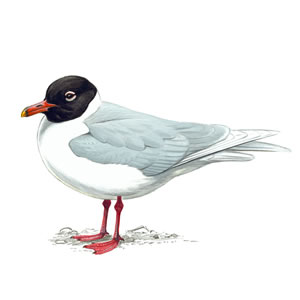Nature notes for Radio Norfolk
This page has some pictures and notes relating to nature discussed on air with Honeyguide's Chris Durdin on BBC Radio Norfolk's Drivetime Show - in this case on 28 February 2011 ... plus an early March update on spring butterflies.
Quiz question - and now the answer, too
Here's a weather forecast. "The sun is out, the sky is blue, there's not a cloud to spoil the view." Which native British tree does this suggest?
For the answer to this and also today's Rural Riddle, scroll down to the bottom right hand corner of this web page.
Flowers for early March
Keep an eye out for sweet violets (above) and lesser celandines (right). Lesser celandine on Wikipedia here. |
 |
Mediterranean gulls at Great Yarmouth
The name suggests there are in the wrong place, and Mediterranean gulls really are found in the Mediterranean, but there is also a substantial and growing population in the North Sea and English Channel. These include several pairs nesting in Norfolk and nearby counties in recent years. But the 'Med' gulls at Great Yarmouth - arguably the best place to see them in the UK - are non-breeding birds. While a few may be seen at any time of year, the adults go to Belgium and Holland to nest - we know that from the rings on the legs of some, which you can see if you look closely.
March is the best time to enjoy them, I think. That's because the adults are coming into their breeding plumage with a full, black hood - really black, unlike the chocolate brown head of black-headed gull and a proper hood, extending farther down their necks than the brown on a black-headed gull. When the head is up - not in this picture - it looks like it's wearing a balaclava.
 |
 |
Mediterranean gull . . . . . . . . . . . . . . . Black-headed gull.
Pictures from www.rspb.org.uk
Also look out for the clean-looking, unmarked, rather rounded wings on the adults, without the black on a black-headed gull's wings. The legs are a deeper red colour.
Fat balls
The RSPB doesn't sell fat balls - suet and seed mixed - in mesh due to reports of birds trapped in the plastic mesh. Here are three ideas so you can keep using this great bird food but reduce the risk.
1) Buy fat balls that are not in a net
2) Put fat balls in a feeder, so birds grab the feeder and not the net. Feeders take fat balls with or without nets - see picture on the right.
3) Tie your fat ball against a small branch so that birds can perch on the branch and not the net. Robins and blackbirds will take advantage, though tits may still land on the mesh. |
Small tortoiseshell
Finally, a couple of pictures to celebrate spring. This small tortoiseshell butterfly, here on elephant's ears flowers Bergenia cordifolia, was in my garden on 7 March. Next butterfly, with any luck, will be a brimstone. (So it proved: one flew past at Hillside Rovers on Saturday 12 March and soon after in my garden.) Both species overwinter as adults so emerge on bright spring days.

